US Supply Chain Management Software Market Size
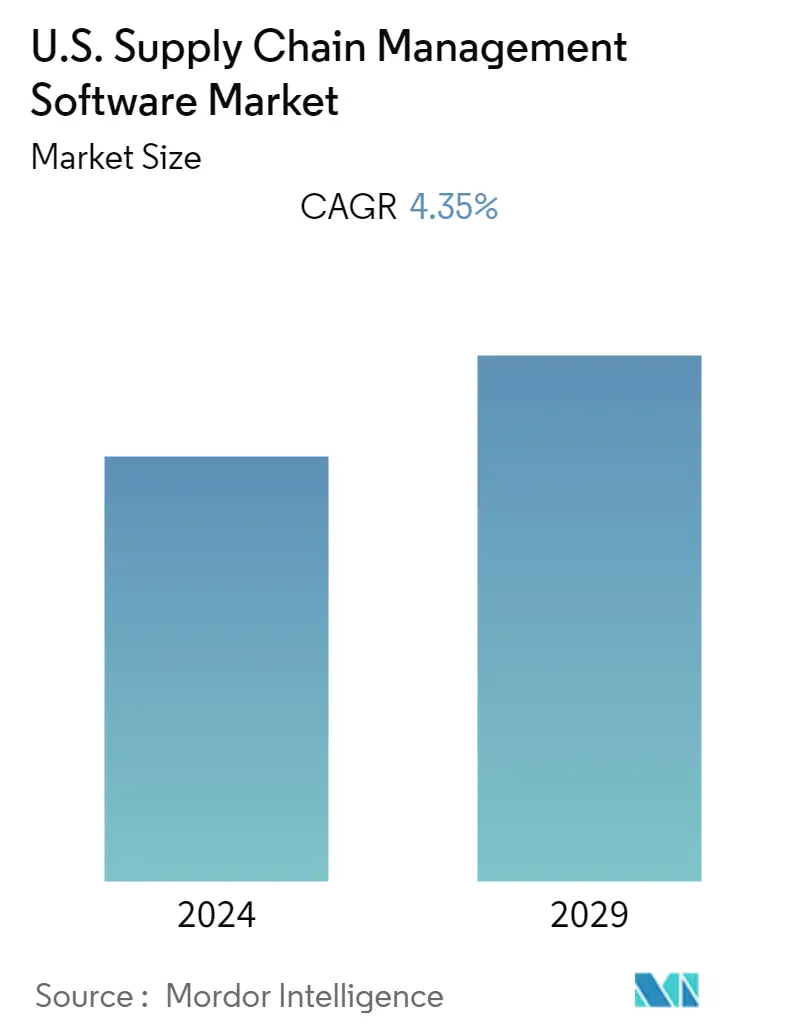
| Study Period | 2019 - 2029 |
| Base Year For Estimation | 2023 |
| Forecast Data Period | 2024 - 2029 |
| Historical Data Period | 2019 - 2022 |
| CAGR | 4.35 % |
| Market Concentration | Medium |
Major Players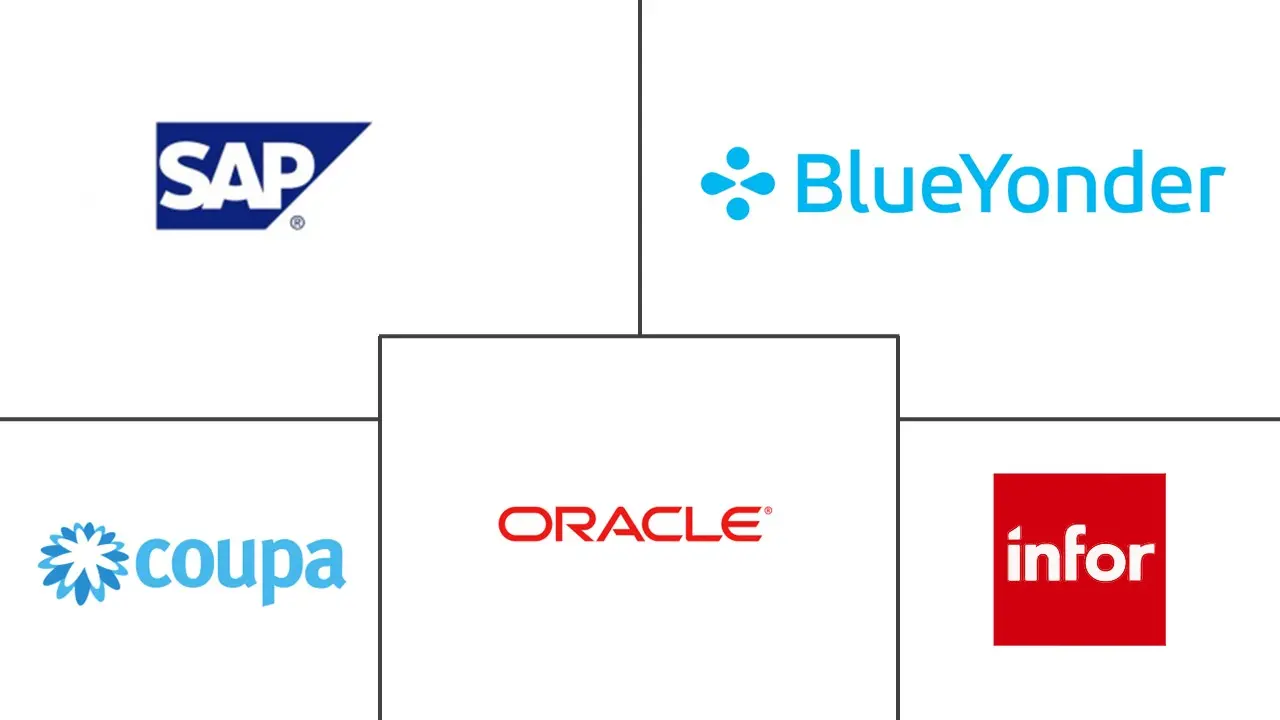
*Disclaimer: Major Players sorted in no particular order |
US Supply Chain Management Software Market Analysis
United States Supply Chain Management Software Market would witness market growth of 4.35% CAGR during the forecast period. SCM software is a real-time analytical platform, and it is used to manage the flow of products and various kinds of information across the supply chain network. Demand for transportation management systems (TMS) software would add to the market expansion during the forecast period. On the other hand, inefficient IT infrastructure in underdeveloped nations and growing security & privacy concerns would limit the growth of the supply chain management software market in the US.
- COVID-19 pandemic is expected to trigger a positive demand for supply chain management software in the US, on account of increased logistics supply-demand in the country, especially for FMCG and essential goods.
- Needs for data insights, customer analysis, and all kinds of business processes have strongly increased due to digitization and data collected online by companies. This development drives the demand for Enterprise Software, especially Business Intelligence (BI) Software. Next to BI, Enterprise Resource Planning (ERP), Customer Relationship Management (CRM), and Supply Chain Management (SCM) Software is included in the Enterprise Software segment. In general, Enterprise Software supports the digitization processes of companies and accounts for almost half of total software revenues. CRM is the leading Enterprise Software segment as customer orientation is important in digital business environments to stand out from the competition.
US Supply Chain Management Software Market Trends
This section covers the major market trends shaping the US Supply Chain Management Software Market according to our research experts:
Cost Savings Due To SCM Software
- The U.S. supply chain management software is expected to be driven by cost savings caused by utilizing SCM software. With businesses going global and increased competition, supply chains are getting more complex. The number of suppliers, orders received/completed, product offerings, and information generated has increased substantially. Using SCM software would reduce the complexity of the process, cost, and resource savings. The need for companies to remain relevant in the market amidst the highly competitive conditions is a crucial driver for the growth of the SCM software market.
- For instance, Home Depot in the United States, one of the biggest retailers selling home improvement and construction products and services, used to have separate logistics management departments in every single physical store to utilize store management-related activities. This was costly as each store had to process the replenishment orders to get the required materials from the suppliers separately. However, with the help of technology and the right SCM software solutions, Home Depot's new centralized inventory and replenishment department's overall performance improved demand forecast accuracy and decreased the cost of operations for the replenishment orders.
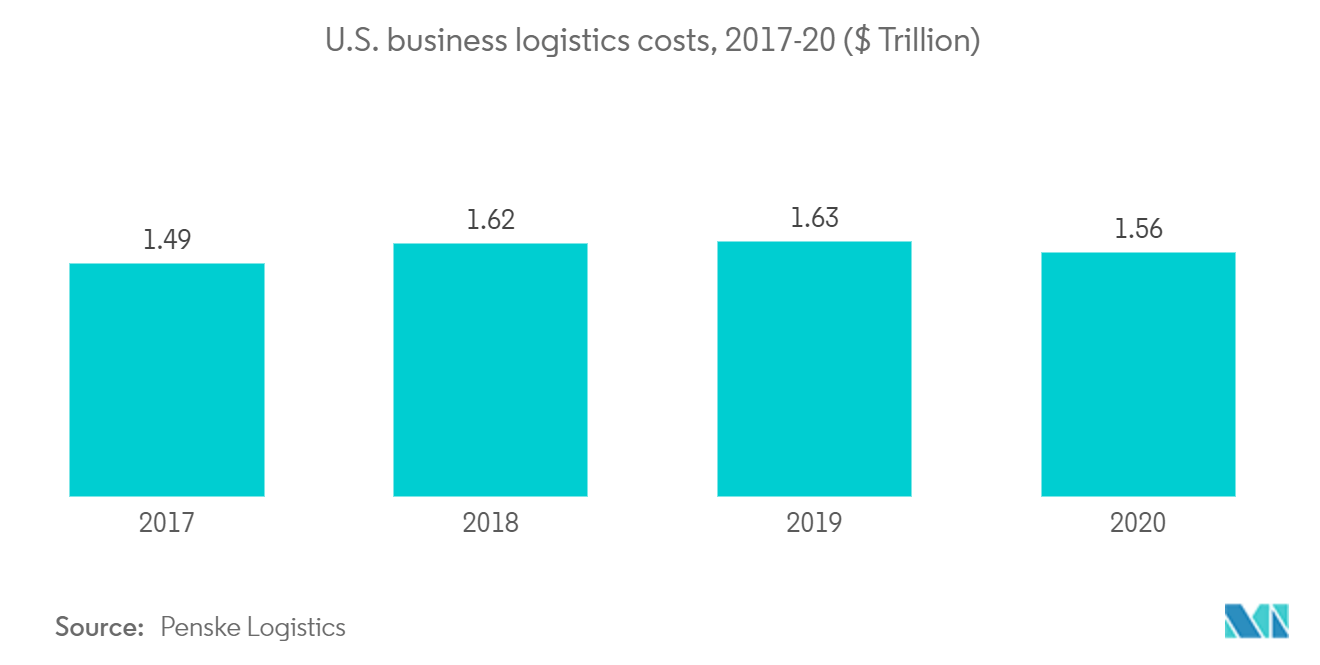
Growth of FMCG Segment
With the onset of COVID-19, many sectors of the economy have experienced a setback, except for FMCG and Pharmaceutical Sectors. These two sectors have experienced an increase in demand as they are a part of the essential goods category. With lockdown restrictions, the Retail eCommerce industry has witnessed a revenue boost. The US Retail eCommerce revenue from food & beverage sales amounted to almost $ 7.3 billion in 2019 and has been increasing since. Amazon had the highest market share among the online food and beverage retailers, followed by Walmart and Kroger. Virtual grocery stores still have higher growth potential as more time-strapped customers look for innovative ways to make their lives easier. However, a significant hurdle for online grocery buys remains freshness, as many customers still prefer to see and touch the product before purchase. To tackle this, Amazon has introduced Amazon Fresh and Prime Pantry, two online grocery shopping services that provide same-day or two-hour delivery. Amazon's food and pantry sales are projected to rise from approximately $ 14.5 billion in 2018 to over $ 23 billion in 2021. Among all the food & beverages categories, Packaged Food segment registered the highest growth percentage, followed by Frozen Foods & Dairy segments.
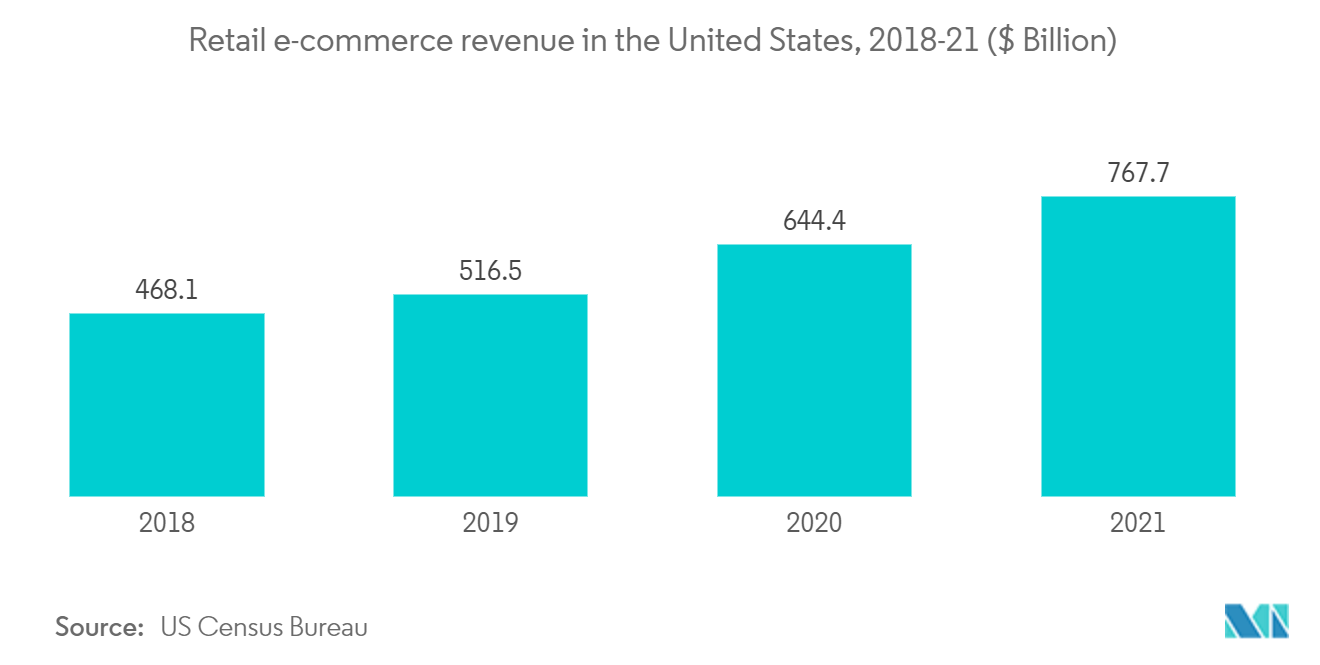
US Supply Chain Management Software Industry Overview
The United States supply chain management software market is a growing market. The current market share is majorly controlled by a few technology companies that have expertise in providing service solutions in the IT domain. Over the forecast period, market players will be differentiated based on the ability to provide remote access/cloud service in FMCG and healthcare supply chain management at competitive costs.
US Supply Chain Management Software Market Leaders
-
Oracle Corporation
-
Infor Inc.
-
SAP SE
-
Blue Yonder
-
Coupa Software
*Disclaimer: Major Players sorted in no particular order
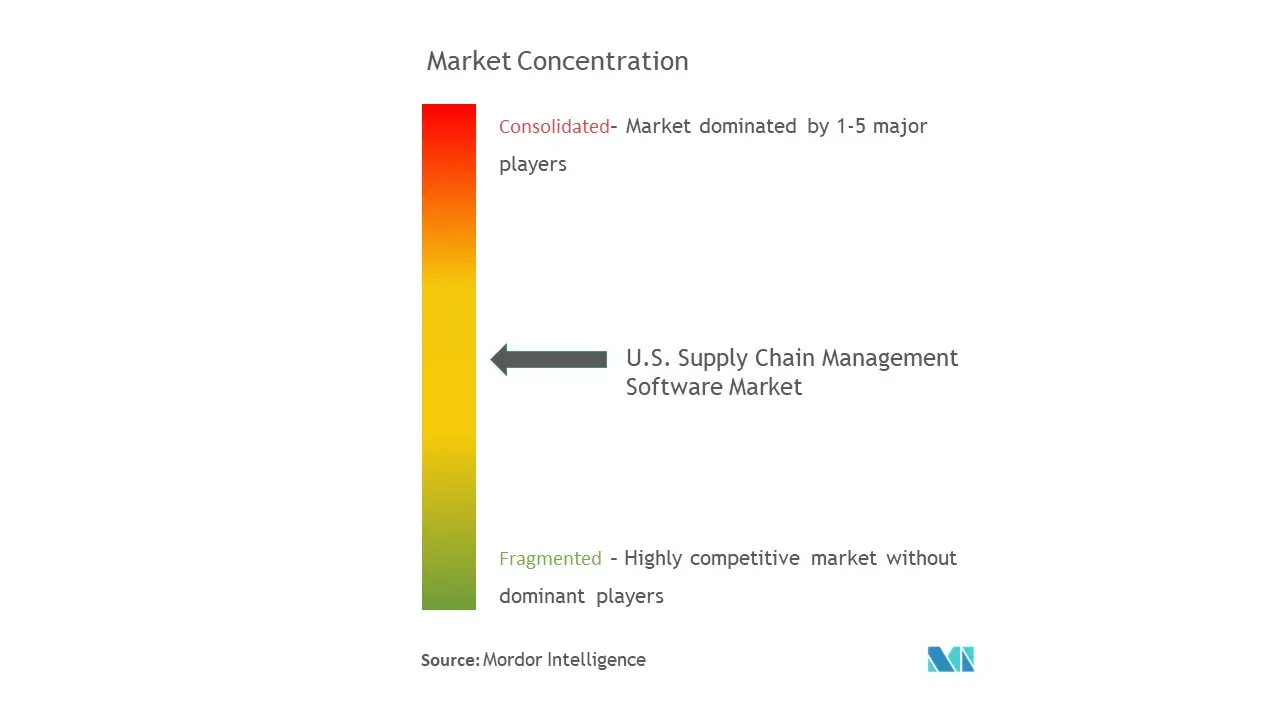
US Supply Chain Management Software Market News
- June 2022: Blue Yonder WMS was built to recognize and react to critical characteristics across industries, from the ability to process various product attributes, support omnichannel commerce and fulfillment, balance shelf life, and productivity for perishables for retailers, or navigate complex regulatory requirements for manufacturers. Blue Yonder's WMS empowers businesses to deliver consistently high service at a value-driven cost. Organizations can drive change with real-time transaction processing, optimized storage and selection strategies, directed task management, and integrated labor standards.
- March 2022: Oracle initiated new logistics management features under its Oracle Fusion Cloud SCM offerings to help enterprises increase their efficiency and value throughout their global supply chain (SCM) operations. Oracle Fusion Cloud International Trade Management and Oracle Fusion Cloud Transportation Management upgrades can assist subscribers in lowering costs and risk, being more adaptive to business challenges, and improving customer experience. Oracle Global Trade Management and Oracle Transportation Management are constantly developing to assist enterprises in dealing with logistics management issues.
US Supply Chain Management Software Market Report - Table of Contents
1. INTRODUCTION
- 1.1 Study Assumptions and Market Definition
- 1.2 Scope of the Study
2. RESEARCH METHODOLOGY
3. EXECUTIVE SUMMARY
4. MARKET INSIGHT
- 4.1 Market Overview
-
4.2 Industry Attractiveness - Porter's Five Forces Analysis
- 4.2.1 Bargaining Power of Suppliers
- 4.2.2 Bargaining Power of Consumers
- 4.2.3 Threat of New Entrants
- 4.2.4 Intensity of Competitive Rivalry
- 4.2.5 Threat of Substitutes
- 4.3 Assessment of COVID-19 impact on the market
5. MARKET DYNAMICS
- 5.1 Increasing growth in e-commerce, increased acceptance of cloud supply chain management among SMEs, and enhancing business processes are all driving demand for SCM software.
- 5.2 Growing investments by supply chain organizations in applications that support artificial intelligence and analytics capabilities
- 5.3 Market Challenges (Lack of Awareness and Integration Complexities)
6. MARKET SEGMENTATION
-
6.1 By Deployment (Market estimates, forecast (2020-2027), trends and other market dynamics)
- 6.1.1 On Premise
- 6.1.2 Cloud (Insights on SCM SaaS offerings- IoT advantage, automation capabilities, centralized control towers etc.)
-
6.2 By Enterprise Size
- 6.2.1 Small and Medium Enterprises
- 6.2.2 Large Enterprises
-
6.3 By End User
- 6.3.1 Manufacturing
- 6.3.2 Healthcare
- 6.3.3 Fast Moving Consumer Goods (FMCG)
- 6.3.4 Oil and Gas
- 6.3.5 Other End-user Industries
7. COMPETITIVE LANDSCAPE
-
7.1 Company Profiles (Business Overview | Product Portfolio | Financials | Business Strategy And Recent Developments, SWOT analysis)
- 7.1.1 Oracle Corporation
- 7.1.2 Infor Inc.
- 7.1.3 SAP SE
- 7.1.4 Blue Yonder
- 7.1.5 Coupa
- 7.1.6 Manhattan Associates
- 7.1.7 Jaggaer, Inc.
- 7.1.8 E2Open
- 7.1.9 WiseTech Global
- 7.1.10 Descartes Systems Group
8. List of Vendors in Vendor management and procurement space
9. INVESTMENT ANALYSIS
10. FUTURE OF THE MARKET
** Subject To AvailablityUS Supply Chain Management Software Industry Segmentation
- Supply chain management software (SCM) is the software modules or tools used in performing supply chain transactions, managing supplier relationships, and controlling associated business processes. Supply chain management software oversees the movement of commodities and data from the point of origin to the point of consumption. Common features of SCM software considered for the study includes inventory management, order management, supplier collaboration, warehouse management, procurement and return management, and analytics.
- Based on deployment market is bifurcated into cloud and on-premise. The market is structured to track the revenues of SCM vendors offering the software across various end-user industries. The pricing models considered for analyzing market estimates includes subscription licensing (per user/per month) and perpetual licensing.
- The study categorizes an in-depth analysis of the utility of software across various end-user industries, such as manufacturing, FMCG, healthcare, oil and gas, and others (retail, utilities, automotive)
- The market study also comprises a brief understanding of the impact of COVID-19 on the market.
| By Deployment (Market estimates, forecast (2020-2027), trends and other market dynamics) | On Premise |
| Cloud (Insights on SCM SaaS offerings- IoT advantage, automation capabilities, centralized control towers etc.) | |
| By Enterprise Size | Small and Medium Enterprises |
| Large Enterprises | |
| By End User | Manufacturing |
| Healthcare | |
| Fast Moving Consumer Goods (FMCG) | |
| Oil and Gas | |
| Other End-user Industries |
US Supply Chain Management Software Market Research FAQs
What is the current U.S. Supply Chain Management Software Market size?
The U.S. Supply Chain Management Software Market is projected to register a CAGR of 4.35% during the forecast period (2024-2029)
Who are the key players in U.S. Supply Chain Management Software Market?
Oracle Corporation, Infor Inc., SAP SE, Blue Yonder and Coupa Software are the major companies operating in the U.S. Supply Chain Management Software Market.
What years does this U.S. Supply Chain Management Software Market cover?
The report covers the U.S. Supply Chain Management Software Market historical market size for years: 2019, 2020, 2021, 2022 and 2023. The report also forecasts the U.S. Supply Chain Management Software Market size for years: 2024, 2025, 2026, 2027, 2028 and 2029.
US Supply Chain Management Software Industry Report
Statistics for the 2024 US Supply Chain Management Software market share, size and revenue growth rate, created by Mordor Intelligence™ Industry Reports. US Supply Chain Management Software analysis includes a market forecast outlook 2029 and historical overview. Get a sample of this industry analysis as a free report PDF download.



